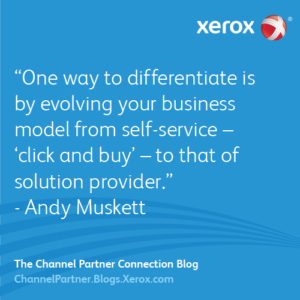
The evolution of the hardware/print market
There was a time, not long ago, when a mobile phone was just a phone for making and receiving calls. Today, we need a phone to perform so many other tasks for us via apps and the Internet – in fact making a call is only 6th on the list of what people do on their smart phones (Hailo market research study 2014). This change was driven, in part, when the mobile phone market reached saturation point and vendors needed to find new solutions in order to differentiate devices.
Interesting, but what’s this got to do with print? Well, the same transition is now taking place within the print hardware market.
As you are no doubt aware the print industry is undergoing significant change and market disruption as vendors look for innovative ways of stimulating a compressed and declining market. Key drivers include:
- Customers are more demanding than ever – they now research proposed purchases online, using unbiased reviews of products, services, and suppliers to aid in their decision-making process
- The technological landscape is constantly shifting – as new products and services are developed and evolve
- There’s more choice – and more competition
All of which threatens the traditional equipment business, along with declining print volumes, hardware commoditisation and lower margins. (Source: Quocirca February 2016)
The industry looks set for a new round of acquisitions (some in the software and services space) and restructuring as vendors look to adapt to market demands. In order to survive OEMs must now deliver more of what customers want and resellers must adapt their business model to meet this need.
Customers are driving change
Consumers want to perform everyday tasks more efficiently. We all bought into the concept of our mobile phones becoming multifunctional devices and improving our productivity; now expectations are that other devices will perform tasks faster and more simply by performing multiple tasks. And, as we know, the market is already changing:
- The rise of colour printing – which has become more affordable and integrated as ‘normal’ (Source: IDC, Worldwide Hardcopy Peripherals Shipment report)
- The decline in demand for single function printers – and the rise in demand for MFPs (Source: TheRecycler.com)
- 73% of employees want to print from their mobiles – but only 14% can (Source – Quocirca, The Mobile Print Enterprise, January 2015)
So if today’s marketplace is saturated and competition is fierce how do you differentiate your business? The answer lies in adding real value to your customers by offering new solutions and services that make their lives easier.
Evolving from transactional partner to solution provider
If you operate a traditional print/supplies sales model, one way to differentiate is by evolving your business model from self-service – ‘click and buy’ – to that of solution provider. This means building bespoke solutions for each customer, which includes helping them to improve the flow of communications and streamlining processes. The possibilities are endless, but examples I’ve seen so far include; approving expenses, on-boarding new employees, document audit and control, manufacturing and design sign-off, and purchase or invoice approvals to name but a few.
Taking a consultative approach means better understanding of the market’s needs, longer-term customer partnerships, loyal customers and more opportunity for annuity-based revenue streams.
Conclusion
Over this blog series we’ve examined how the print, supplies and services markets are evolving. We’ve speculated on the future and offered our opinions and advice in the face of inevitable change. We want you to survive and thrive and we’re here to help make that happen.
Contact your Xerox account manager, or review the Xerox Global Partner Program and apply to become a Xerox channel partner today, to find out how we will help grow your business.
Subscribe to the Channel Partner Connection and receive email updates when we publish a new article.



